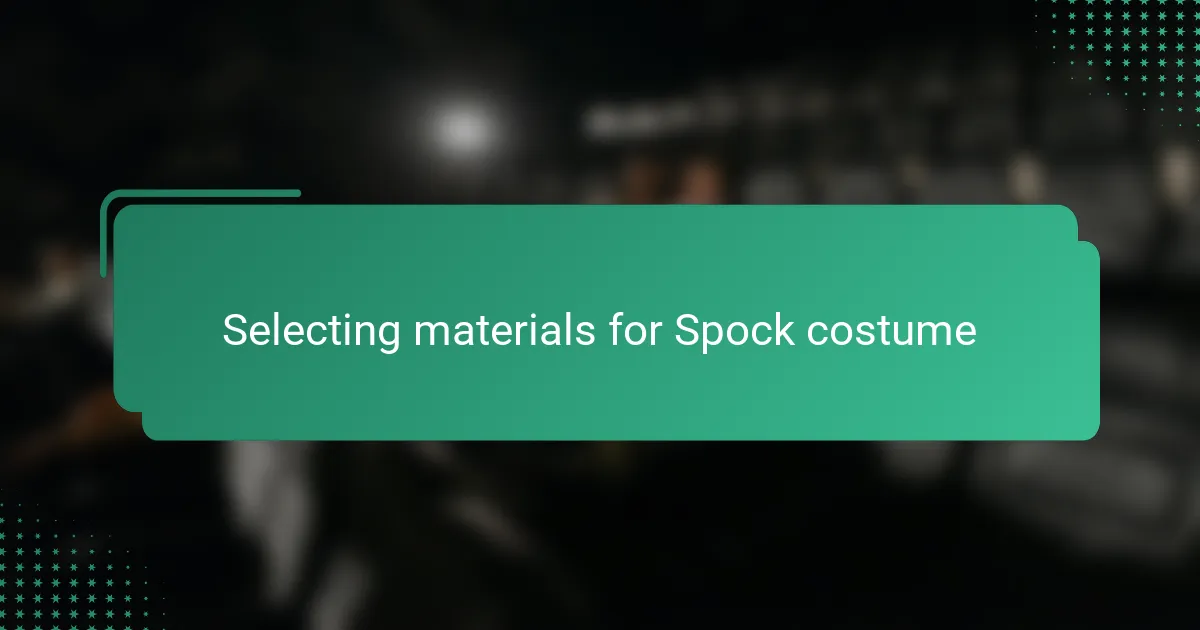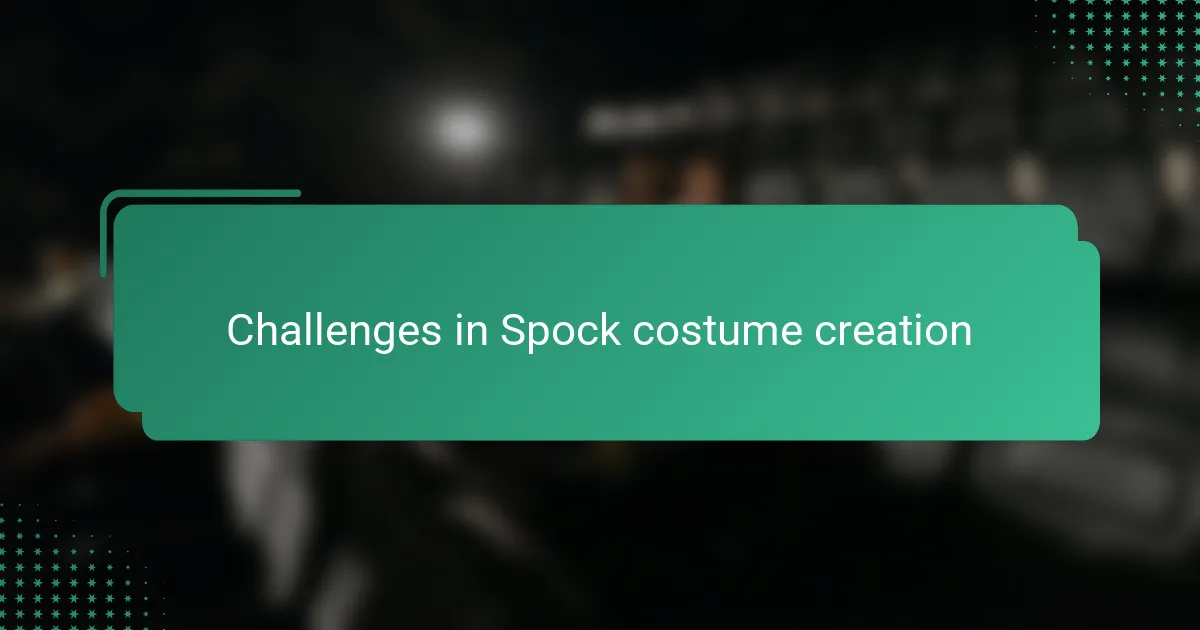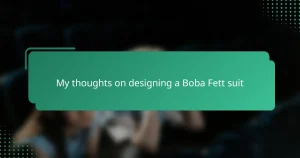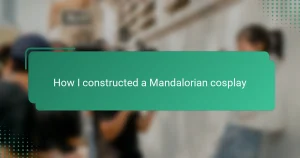Key takeaways
- Science fiction props serve as storytelling tools, blending creativity and functionality to create believable worlds.
- Attention to detail is crucial in costume design, from understanding character nuances to choosing the right materials for authenticity.
- The design process involves sketching, prototyping, and fine-tuning, highlighting the balance between creativity and problem-solving.
- Small finishing touches, such as weathering, fitting adjustments, and grooming, significantly enhance the overall costume look and feel.

Understanding science fiction props
Science fiction props are more than just objects; they’re storytellers that bring imaginary worlds to life. I’ve often found that understanding the intent and detail behind a prop helps me connect deeply with the character it represents. Have you ever noticed how a simple gadget can evoke an entire universe just by its design?
When I first delved into creating science fiction props, I realized that every piece carries a purpose, blending creativity with functionality. This duality fascinates me because it challenges me to think like both an artist and an engineer, crafting something believable yet otherworldly.
The beauty of sci-fi props lies in their ability to spark imagination. By studying their textures, materials, and cultural significance within their fictional worlds, I find myself walking the fine line between reality and fantasy—something I strive to capture in every costume I design.

Essential features of Spock costumes
When I started designing a Spock costume, the first thing I knew was that the iconic pointed ears simply couldn’t be overlooked. Those ears are more than just a detail; they’re a symbol of Spock’s Vulcan heritage and instantly recognizable to any fan. Getting the right shape and attachment felt crucial—too big or too small, and the whole effect falls flat.
The blue tunic with the Starfleet insignia was another non-negotiable element for me. Wearing it, I could almost feel the calm logic Spock embodies, and replicating that precise shade of blue took more trial and error than I expected. Do you ever find yourself obsessing about color because it carries so much meaning? That was definitely me.
Lastly, the structured, minimalistic style of the costume stood out as essential. Spock’s look isn’t flashy; it’s clean and purposeful, much like his personality. Capturing that subtle discipline in fabric choice and cut made me appreciate how costume design is a form of character study, not just decoration.

Selecting materials for Spock costume
Choosing the right materials for the Spock costume was a surprisingly thoughtful process. I knew the fabrics had to reflect Spock’s sleek and practical style without appearing too flashy or cheap. Finding a fabric that felt smooth and slightly rigid captured that logical, disciplined vibe I associate with his character.
I also thought a lot about texture—would a shiny polyester tunic look too modern and lose that classic sci-fi feel? After testing a few swatches, I settled on a medium-weight knit with just enough stretch to allow movement without compromising the sharp lines of the design. Have you ever noticed how fabric choice alone can transform the whole aura of a costume?
The ears were another material challenge. Silicone seemed perfect for their realistic flexibility, but attaching them securely while keeping them comfortable required some trial and error. I wanted them to look just right, like they belonged naturally, not like a last-minute add-on. Balancing aesthetics with wearability became a mini science experiment in itself.

Step by step design process
The first step in my design process always involves sketching out rough concepts, playing with proportions and details until the look feels just right. I remember sitting with my pencil, trying to capture Spock’s understated demeanor—not easy when you’re balancing sharp lines with soft fabric folds. Have you ever found that translating a character’s essence onto paper is both exhilarating and humbling?
Once the sketches felt solid, I moved on to creating prototypes, especially for those tricky elements like the ears and collar. It was a hands-on dance of cutting, fitting, and reworking—sometimes frustrating, often rewarding. Each iteration taught me something new about how materials behave versus how they look in my mind.
Finally, assembling all the parts into a cohesive costume required patience and a good eye for detail. I tested different stitching techniques and placements to ensure durability without sacrificing the sleek appearance. It struck me that design is as much about problem-solving as it is about creativity—have you ever considered how many tiny decisions shape the final result?

Techniques for accurate costume details
When it came to nailing the accurate details of Spock’s costume, I found that close observation was absolutely key. I spent hours studying screen captures and even paused episodes frame by frame to see how light hit the folds and seams. Have you ever caught yourself obsessively zooming in on details you might’ve missed at first glance? That’s exactly how I learned what subtle stitching or fabric weight really made the costume pop.
One technique I swore by was creating small sample patches for tricky details, like the Starfleet insignia’s exact embroidery and the collar’s sharp edges. Testing these snippets helped me avoid costly mistakes later on, and honestly, it felt like solving a miniature puzzle each time. There’s something satisfying about seeing a tiny piece come together perfectly before tackling the bigger picture.
I also relied heavily on layering my work process—building up from simple shapes to complex details gradually. This helped me stay organized and kept the accuracy tight without feeling overwhelmed. In those moments, I realized that replicating a costume isn’t just about copying; it’s about understanding why each element exists and how it contributes to the whole character’s story. Doesn’t that make the task feel both more challenging and more rewarding?

Challenges in Spock costume creation
One of the biggest challenges I encountered was achieving the perfect fit for the tunic. Spock’s costume needs to look sleek without being restrictive, which meant balancing fabric stretch and structure. Have you ever tried on something that looks great hanging on a mannequin but feels entirely different when you wear it? That was my daily struggle.
The pointed ears presented their own set of headaches. I remember spending hours adjusting the silicone models, agonizing over every small tweak to avoid that fake, “mask-like” appearance. How do you make something so alien look natural on a human head? That question kept me puzzling late into many nights.
Lastly, replicating the exact shade of blue seemed straightforward but turned into a surprisingly persistent challenge. I mixed and tested countless dyes and fabric swatches, chasing that iconic Starfleet shade. It felt less like costume making and more like a small chemistry project—who knew colors could be so emotional?

Tips for costume finishing touches
When I reached the finishing stage of my Spock costume, I learned that small details truly make a big difference. Adding subtle weathering or carefully chosen accessories can elevate the look, making it feel worn-in and authentic rather than brand new. Have you ever noticed how a tiny scuff or a slight fabric crease can bring a costume to life? I definitely have, and those finishing touches gave my costume the final spark.
Another tip I can’t emphasize enough is the importance of final fitting adjustments. After assembling the main pieces, I spent time tweaking seams and hems to ensure the costume moved naturally with me. It’s amazing how a slight alteration in fit can boost comfort and confidence—like when the collar sits just right or the sleeves fall perfectly. Doesn’t that level of polish make wearing the costume much more enjoyable?
Lastly, paying attention to makeup and hair makes all the difference. For Spock, that meant precise eyebrow shaping and a neat hairstyle, which framed the costume and completed the transformation. I found that without these final grooming touches, the costume risked looking incomplete. Have you ever tried on a costume and felt something was missing? That’s often the subtle personal flair that finishes the look.


